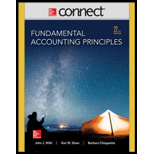
FUND.ACCT.PRIN -ONLINE ONLY >I<
22nd Edition
ISBN: 9780077632878
Author: Wild
Publisher: MCG
expand_more
expand_more
format_list_bulleted
Question
Chapter 8, Problem 12E
a)
To determine
Introduction:
Ratio Analysis
- Ratio analysis is a study of several key metrics of a company based on the data presented in its’ financial statements with an objective to evaluate the financial health of a company.
- It is essential for investors, stakeholders, government bodies etc. to evaluate the key metrics of an entity in order to ensure that the company fulfills the going concern principle and displays financial stability.
The key metrics mentioned above include the following:
- Days’ sales uncollected − A measure of the total outstanding collections for credit sales in number of days.
- It is a measure used by companies to calculate their average collection period and understand how well accounts receivables are being managed.
To Determine:
Days sales uncollected for 2014 and 2015
b)
To determine
Introduction:
Ratio Analysis
- Ratio analysis is a study of several key metrics of a company based on the data presented in its’ financial statements with an objective to evaluate the financial health of a company.
- It is essential for investors, stakeholders, government bodies etc. to evaluate the key metrics of an entity in order to ensure that the company fulfills the going concern principle and displays financial stability.
The key metrics mentioned above include the following:
- Days’ sales uncollected − A measure of the total outstanding collections for credit sales in number of days.
- It is a measure used by companies to calculate their average collection period and understand how well accounts receivables are being managed.
To Determine:
Changes in Liquid assets held in receivables in the years 2014 and 2015
Expert Solution & Answer
Want to see the full answer?
Check out a sample textbook solution
Students have asked these similar questions
I am looking for the correct answer to this general accounting problem using valid accounting standards.
I am trying to find the accurate solution to this general accounting problem with the correct explanation.
None
Chapter 8 Solutions
FUND.ACCT.PRIN -ONLINE ONLY >I<
Ch. 8 - Prob. 1DQCh. 8 - Prob. 2DQCh. 8 - Prob. 3DQCh. 8 - Prob. 4DQCh. 8 - Prob. 5DQCh. 8 - Prob. 6DQCh. 8 - Prob. 7DQCh. 8 - Prob. 8DQCh. 8 - Prob. 9DQCh. 8 - Prob. 10DQ
Ch. 8 - Prob. 11DQCh. 8 - Prob. 12DQCh. 8 - Prob. 13DQCh. 8 - Prob. 1QSCh. 8 - Prob. 2QSCh. 8 - Prob. 3QSCh. 8 - Prob. 4QSCh. 8 - Bank reconciliation P3 For each of the following...Ch. 8 - Prob. 6QSCh. 8 - Prob. 7QSCh. 8 - Prob. 8QSCh. 8 - Prob. 9AQSCh. 8 - Purchase discounts An important part of cash...Ch. 8 - International accounting and internal controls C1...Ch. 8 - Prob. 1ECh. 8 - Prob. 2ECh. 8 - Prob. 3ECh. 8 - Prob. 4ECh. 8 - Prob. 5ECh. 8 - Prob. 6ECh. 8 - Prob. 7ECh. 8 - Prob. 8ECh. 8 - Prob. 9ECh. 8 - Prob. 10ECh. 8 - Prob. 11ECh. 8 - Prob. 12ECh. 8 - Prob. 13AECh. 8 - Prob. 14BECh. 8 - Prob. 1APSACh. 8 - Prob. 2APSACh. 8 - Prob. 3APSACh. 8 - Prob. 4APSACh. 8 - Prob. 5APSACh. 8 - Prob. 1BPSBCh. 8 - Prob. 2BPSBCh. 8 - Prob. 3BPSBCh. 8 - Prob. 4BPSBCh. 8 - Prob. 5BPSBCh. 8 - Prob. 8SPCh. 8 - Prob. 1GLPCh. 8 - Prob. 1BTNCh. 8 - Prob. 2BTNCh. 8 - Prob. 3BTNCh. 8 - Prob. 4BBTNCh. 8 - Prob. 5BTNCh. 8 - Prob. 6BTNCh. 8 - Prob. 7BTNCh. 8 - Prob. 8BTNCh. 8 - Prob. 9BTN
Knowledge Booster
Learn more about
Need a deep-dive on the concept behind this application? Look no further. Learn more about this topic, accounting and related others by exploring similar questions and additional content below.Similar questions
- Can you help me solve this general accounting question using the correct accounting procedures?arrow_forwardI need the correct answer to this general accounting problem using the standard accounting approach.arrow_forwardPlease help me solve this general accounting question using the right accounting principles.arrow_forward
- I am searching for the accurate solution to this general accounting problem with the right approach.arrow_forwardCan you explain the correct methodology to solve this general accounting problem?arrow_forwardI need help solving this general accounting question with the proper methodology.arrow_forward
arrow_back_ios
SEE MORE QUESTIONS
arrow_forward_ios
Recommended textbooks for you

 AccountingAccountingISBN:9781337272094Author:WARREN, Carl S., Reeve, James M., Duchac, Jonathan E.Publisher:Cengage Learning,
AccountingAccountingISBN:9781337272094Author:WARREN, Carl S., Reeve, James M., Duchac, Jonathan E.Publisher:Cengage Learning, Accounting Information SystemsAccountingISBN:9781337619202Author:Hall, James A.Publisher:Cengage Learning,
Accounting Information SystemsAccountingISBN:9781337619202Author:Hall, James A.Publisher:Cengage Learning, Horngren's Cost Accounting: A Managerial Emphasis...AccountingISBN:9780134475585Author:Srikant M. Datar, Madhav V. RajanPublisher:PEARSON
Horngren's Cost Accounting: A Managerial Emphasis...AccountingISBN:9780134475585Author:Srikant M. Datar, Madhav V. RajanPublisher:PEARSON Intermediate AccountingAccountingISBN:9781259722660Author:J. David Spiceland, Mark W. Nelson, Wayne M ThomasPublisher:McGraw-Hill Education
Intermediate AccountingAccountingISBN:9781259722660Author:J. David Spiceland, Mark W. Nelson, Wayne M ThomasPublisher:McGraw-Hill Education Financial and Managerial AccountingAccountingISBN:9781259726705Author:John J Wild, Ken W. Shaw, Barbara Chiappetta Fundamental Accounting PrinciplesPublisher:McGraw-Hill Education
Financial and Managerial AccountingAccountingISBN:9781259726705Author:John J Wild, Ken W. Shaw, Barbara Chiappetta Fundamental Accounting PrinciplesPublisher:McGraw-Hill Education


Accounting
Accounting
ISBN:9781337272094
Author:WARREN, Carl S., Reeve, James M., Duchac, Jonathan E.
Publisher:Cengage Learning,

Accounting Information Systems
Accounting
ISBN:9781337619202
Author:Hall, James A.
Publisher:Cengage Learning,

Horngren's Cost Accounting: A Managerial Emphasis...
Accounting
ISBN:9780134475585
Author:Srikant M. Datar, Madhav V. Rajan
Publisher:PEARSON

Intermediate Accounting
Accounting
ISBN:9781259722660
Author:J. David Spiceland, Mark W. Nelson, Wayne M Thomas
Publisher:McGraw-Hill Education

Financial and Managerial Accounting
Accounting
ISBN:9781259726705
Author:John J Wild, Ken W. Shaw, Barbara Chiappetta Fundamental Accounting Principles
Publisher:McGraw-Hill Education
Financial ratio analysis; Author: The Finance Storyteller;https://www.youtube.com/watch?v=MTq7HuvoGck;License: Standard Youtube License